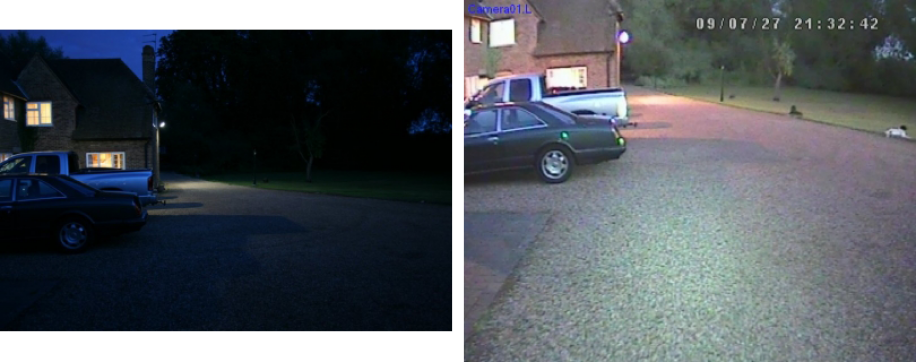Home > Help & Advice > CCTV buying guide > Camera Buying Guide > Camera Basics
Camera Basics
A quick word on camera basics
As with the human eye, light enters the camera through a lens, it then hits an electronic sensor, the equivalent of our retina. This sensor turns the image into an electronic signal. The electronic signal goes to a processor called a DSP or "chipset" where it is processed and adjustments made for different light conditions, the DSP does the same job as our brain in the human eye comparison.
CCD and CMOS sensors - the camera's retina
There are 2 types of camera sensors. CMOS (short for complementary metal-oxide semiconductor), sensors require a lot more off-chip circuitry to clean up the image if you want a high-quality result. Costing less to produce CMOS sensors offers a cheap solution at the expense of quality for lower-resolution applications. CCD sensors (short for charge-coupled devices) are more expensive to produce but the image quality is generally higher needing less electronic "touching up". Most professional cameras tend to use CCD technology.
1/4 inch or 1/3 inch CCD Sensor - why 1/3 inch is better
This measurement refers to the size of the CMOS or CCD image sensor used in a camera. Smaller image sensors are less sensitive to light and are more likely to suffer image deterioration or "noise". 1/4 inch sensors measure 7.68mm² (3.2mm by 2.4mm). 1/3 inch sensors measure 17.28mm² (4.8mm by 3.6mm). So a 1/3" sensor is 225% the size of a 1/4" sensor - a significant increase. Try to buy cameras with 1/3 inch sensors, particularly at the lower end of the market where manufacturers will be fitting cheaper DSP or chipsets.
Just because a camera claims to have a Sony 1/3-inch CCD sensor doesn't make it a good camera. You need to know exactly what electronics have been used and then ensure it has the most suitable lens for your application.
DSP (sometimes called the chipset) - the brain of the camera
The type of processing chipset or DSP is equally as important as the CCD sensor. We have worked very hard with manufacturers to come up with the best combination to suit individual cameras. The ability to film in low light levels, how adaptable the camera is to different lighting or climatic conditions and ease of use are all affected by the choice of DSP. A lot of manufacturers go way overboard when packing DSP-based features in their cameras to the point where even professional installers don't fully understand them. We like a nice simple "does what it says on the tin" solution with settings automatically selected by the camera.
A word of warning: we see many non-genuine sensors and chipsets where the original manufacturer's name is removed and replaced with a brand name such as Sony. We work hard to ensure the provenance of all components within our cameras. We do this by selecting manufacturing partners very carefully. It helps greatly that we travel overseas and have regular direct contact with manufacturers.
Lux Levels - how well a camera performs in low light or infra-red light
This refers to how much light is required for the camera to be able to "see". We have chosen Sony CCD and DSP combinations which ensure the vast majority of our cameras can see down to 0.01lux without infrared lighting. Their sensitivity also ensures superb results when used with a camera's built-in infrared lighting. When evaluating cameras we notice massive differences in low-light performance.
Some cameras artificially "boost" light levels but take these figures with a pinch of salt. The resultant images at maximum boosted levels are very poor because as well as boosting the subject they also amplify "noise" and other unwanted parts of the image so take ridiculously low lux figures with a pinch of salt.
These pictures show how well our Pro Sony electronics pack 0.01 lux cameras perform in low-light conditions
What the human eye sees and What our 0.01 lux cameras see

These photos are not a trick, our 0.01 lux cameras really do perform that well, to the extent that sometimes when you leave the office after looking at the CCTV monitor you are shocked at how dark it's become outside!
Lens focal length (measured in mm) - The most important thing to get right when selecting a camera
This refers to the focal length of a lens, not its diameter. The smaller the number the wider the field of view and also the more light it lets in. The bigger the number the narrower the field of vision, the more telephoto it becomes, (like a pair of binoculars) and the camera is able to detect a higher level of detail. With a 1/3 inch CCD camera 4mm or less would be considered wide-angle, 9-10mm or more telephoto. Remember those wide-angle lenses provide greater area coverage but at the expense of detail as you move away from the camera. A 3.6mm lens won't be able to capture detail more than 4-5 metres from the camera. So when you see 3.6mm cameras that claim ranges of 15 - 20 metres this is pure fantasy. A more telephoto lens can show increased detail over a narrower angle of view. This is the single most important thing to get right when choosing cameras. don't be afraid to call us for advice.
